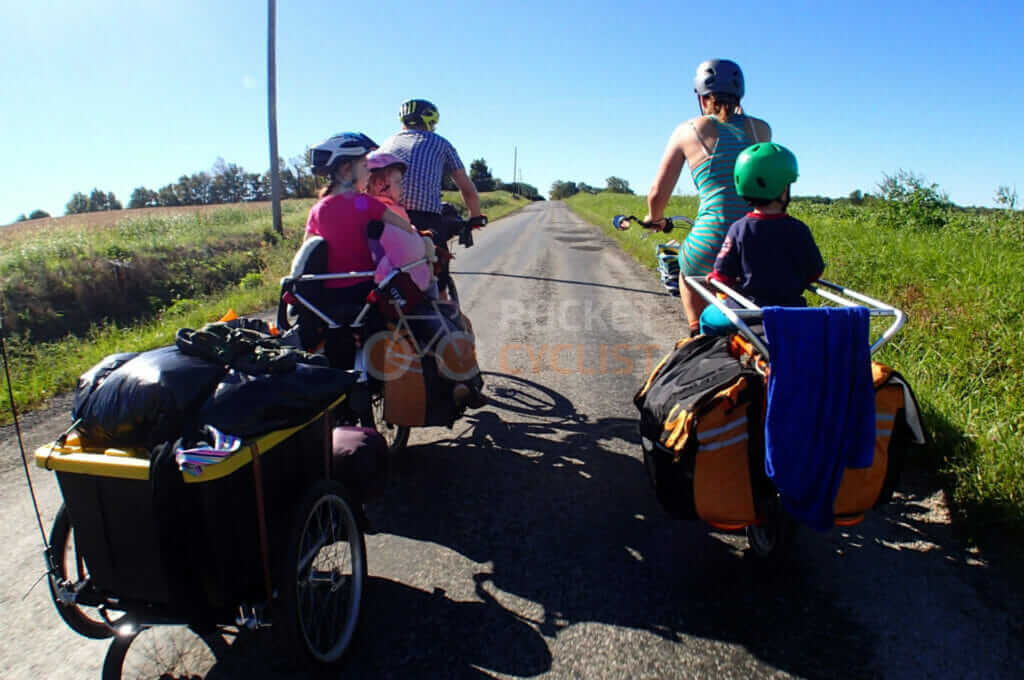Last Updated on February 9, 2024 by Vinson Lozano

Are cargo bikes easy to ride? It’s a fair question given their growing popularity with cyclists who are after convenient and efficient ways of getting around.
These larger bicycles can indeed handle heavier loads over longer distances, although it doesn’t necessarily mean they’re easier rides than traditional bikes.
The challenge here is that there’s no one-size fits all solution – different models come in various designs, sizes and weight capacities so some may be more difficult to maneuver through tight spots or up hills compared to others.
But fortunately, certain cargo bike manufacturers have kept comfortability in mind while designing theirs – incorporating ergonomic features which make them simpler for people of any skill level when controlling at virtually any speed!
If you understand the basics about bicycle mechanics then you shouldn’t really find yourself struggling too much on your first time riding a cargo bike!
Understanding the Concept of Cargo Bikes
Cargo bikes have certainly been around for a while, becoming increasingly popular in many cities. They offer an easy solution to carrying items such as groceries, tools and other goods from one place to another – but what exactly makes cargo bikes so special? How do they work? Are they straightforward enough that you can get the hang of riding them quickly?
Well, cargo bicycles come in all kinds of shapes and sizes. Some are specifically designed for long-distance rides with heavier loads; others are built like regular cycles except bigger – perfect if you want extra storage space without sacrificing speed or agility!
Some models come with a large cargo box that you can attach either on the back or front of your bike’s frame. This is great for holding all sorts of things from books and bags to furniture, as well as small appliances! Other bikes have longer racks, so they can carry multiple items at once.
The most common type, however, is the long-tail bike. It has two wheels in the rear which sit further behind than usual for more stability when carrying heavier loads. Interesting fact – some bikers use their long-tail bikes to transport groceries around town instead of using cars or public transportation!
Riding a cargo bike isn’t that much different from riding any other type of bicycle, it’s just carrying more weight. Balance is the key factor here since you’ll have to pay extra attention while riding with heavier loads on your bike; this means there will be more strain and pressure on the frame and tires.
In general, it’s advisable not to load up anything over 50% of your own body weight (e.g 40 lbs if you weigh 200 pounds). That said, having done some research surely helps in making sure everything is balanced out nicely when loading your cargo for an enjoyable ride!
When it comes to cargo bikes, whether they’re easy for new riders is largely dependent on their experience with cycling in general. Newcomers may be intimidated initially but should become comfortable after some practice rides around the neighborhood or park trails!
To stay safe while riding one of these bicycles, make sure to follow basic safety protocols like wearing a helmet (as per local laws) – this will ensure that you don’t overloaded yourself and can handle your bike without any extra trouble.
Key Features and Design of Cargo Bikes

Cargo bikes are getting more and more popular, as they provide an awesome way of transporting stuff in places with restricted area. They’re simple to ride on and come loaded with lots of different features and designs that make them look even cooler.
One standout advantage these cargo bikes have is the low center of gravity – it makes riding them easier when space is tight. This explains why they’re perfect for cities where roads can be crowded or not so wide- open!
Frames of cargo bikes also tend to be lightweight, which makes it easier for riders to lug them upstairs or take onto public transportation whenever needed. Design-wise, many cargobikes come equipped with copious baskets and boxes at the front or on the back that allow us store groceries and other items in safely.
Plus, some models are adjustable, so they can accommodate multiple sized people/loads as well as have removable handles allowing you to switch between riding positions in a flash without having to dismantle anything!
Cargo bikes usually come with bigger wheels than traditional bicycles, providing more stability to carry heavy loads on rough terrain. The tires are thicker too compared to regular bicycle ones for heavier weights without any detriment in bike performance when not carrying anything.
As an added bonus, many cargo bikes have their own lighting system built-in, so no additional lights need attaching for riding at night – perfect peace of mind while you stay visible even if hauling tons of stuff! This makes them really useful for commuters and students moving around cities or college campuses.
The Level of Difficulty in Riding Cargo Bikes
When it comes to cargo bikes, there is a wide range of difficulty levels. The type and purpose of the bike determine how difficult they are to ride. For instance, leisurely riding on a mountain bike with just front basket attached will be much easier than hauling heavy loads up on full-size cargo bike that can support weights as big as 400 pounds!
It’s not only size what matters when talking about overall difficulty – shape does play an important role too.
Cargo bikes usually have an upright seating position, making them simpler to balance while pedaling. However, they can require more effort when turning since generally speaking they are heavier than regular bicycles.
The frame design has a major impact on how challenging it is to ride the cargo bike – certain designs offer low centres-of-gravity which enable riders to navigate through tight spaces or around corners with hardly any struggle; other models equipped with higher centers may be difficult and call for extra exertion from cyclists upon turning or coming into sudden halts.
In addition, some versions come fitted with electric motors that provide additional energy over rough terrain like hills and sand dunes, but this will naturally raise both cost and complexity levels as well.
When talking about level ground performance, experienced bicyclists should discover no trouble in controlling any sort of cargo bike if paying attention towards their body posture during turns/stops as well as wisely selecting gears matching their pace requirements; all these criteria help ensure you make the most out of every single bicycle outing!
Benefits of a Cycling Commute with Cargo Bikes
Riding a cargo bike for commuting is packed with benefits. To start off, it’s super convenient cause you don’t have to worry about parking your car or finding any space. Just get on and go! What’s more, this mode of transport is way better for the environment compared to driving since no emissions are created (zilch!), which means there won’t be air pollution due to cycling.
Lastly, hauling heavy loads – like groceries or other items – doesn’t need extra transportation as these bikes can handle them just fine – how awesomely useful is that?
Finally, cycling also has some awesome health benefits. You can burn calories and improve your cardiovascular health while having a blast outside of your home. Plus, cargo bikes were made specifically for carrying heavier items – they’ve got bigger wheels which make them much easier to ride compared to other bicycles out there!
Cargo bikes come with all sorts of accessories that can be used depending on what you need to lug around – baskets, boxes attached at the front or back of your bike, special racks for kids and pets, extra cushioning if you’re riding a long distance…you name it.
Cargo bikes typically have longer frames which make them more solid when cycling over bumpy terrain and their weight is spread out much better than conventional bicycles so they are much easier to maneuver even when carrying heavy stuff like bags filled with groceries or any other items that require moving from one place to another.
Do cargo-bikes help alleviate these issues? Absolutely!
Exploring Bike Storage Solutions for Cargo Bikes

Cargo bikes have become a popular option for cycling fanatics and city dwellers. They provide immense carrying capacity which is great for cyclists who need to transport their groceries, tools or other items on the go.
But when it comes to storage solutions? People with limited space in their garages or sheds may be worried about how they can store this new ride of theirs! Well, luckily there are plenty of convenient options that make storing cargo bikes easy breezy! Have you tried them out yet?
Storing a cargo bike is often done by using wall mounts or racks. These can be installed on any inner wall of your house or garage, granting you safe storage for what could otherwise become clutter in your living space.
To maximize the amount of room to work with and ensure compatibility with whichever model bicycle you have, horizontal and vertical rack options are available; it’s up to you which one works best!
Questions arise such as: how much free-space do I have? What style mount would help my particular bike? By answering these questions ahead of time, you’ll make sure that whatever mount/rack combo chosen will accommodate all aspects necessary for proper mounting.
Floor-mounted stands are an alternative for people who want even more stability than wall mounts. They come in a variety of sizes so you can find one that fits your bike or cargo bicycle perfectly. Floor mount systems keep the cycle off the ground and provide easy access when needed, which is great if you don’t have much storage space to spare.
And then there’s foldable stands – why buy something bulky like a full stand when it isn’t necessary? These compact models save floor space since they’re easily folded up against the wall, meaning no unsightly clutter from unused equipment!
If neither wall mount nor floor stand appeals to you, there are other creative solutions available. For example, hanging systems allow you to hang your bike from the ceiling with special hooks attached directly into joists above – a great idea if space is limited but somewhere secure for your ride’s storage needed!
And lastly, if nothing else seems viable then traditional methods such as leaning against walls could be an option too – although it isn’t optimal since this type of storage solution doesn’t provide much security and keeps things out in plain sight.
No matter which choice works best for you, exploring these options will ensure that finding suitable place for storing cargo bikes won’t become an obstacle on your way to reap all its wonderful benefits!
Tips for an Easy Ride on a Cargo Bike
Riding a cargo bike can provide great convenience, but if you’re not accustomed to one it might be difficult. Most of these bikes come with large frames and wide handlebars which make them hard for novice cyclists to control.
Fortunately though, there are some tips that should help make the ride easier. Before anything else, you must ensure your bike is properly sized according to your body type – riding an ill-fitting frame will surely bring nothing more than discomfort during cycling!
It’s essential to regulate your handlebars and seat height so that when seated on the saddle, with feet planted firmly in place, you can easily reach both brake levers while still maintaining an upright posture.
Practicing is just as important before taking to the roads or trails – mastering how to turn without skidding or unbalancing yourself takes time and practice! To begin with take it slow in a secure spot such as an empty parking lot then gradually build up speed depending on how confident you feel riding along.
You might want to find some friends who own cargo bikes so that they can give you advice based on their personal experience. When riding your cargo bike, stay alert and look out for road signs, traffic lights and other vehicles, especially cars.
Furthermore, be aware of any potholes or bumpy surfaces which could make the ride unstable when carrying a heavy load – in addition take extra care while turning as it is one of the most difficult parts about learning how to operate a larger frame bicycle such as a cargo bike! Is there anything else we need to remember?
Comparing Regular Bicycles and Cargo Bikes

Cargo bikes are definitely on the rise and it’s no wonder why – they provide a great way of transporting goods, be it groceries or furniture, without using cars. But how do cargo bikes measure up against regular bicycles?
Well that’s an easy one to answer: Cargo bikes have tons more advantages than ordinary cycles! To begin with their size is much bigger and come equipped with some potent motors; this makes them ideal for lugging heavy stuff around. Also their frames tend to be heavier compared to normal bicycles which make them even better suited for carrying larger loads.
The bigger tires on cargo bikes are a really convenient feature. They provide more stability and traction when riding on roads with bumps or other off-road terrain. Plus, if you’re looking for that extra bit of power to haul heavier loads then some models also come equipped with an electric motor which can give you just the boost you need – hauling heavy stuff has never been easier!
Another great thing about cargo bikes is that they offer riders more control over their ride since it’s much simpler to adjust both the brakes and gears in line with different terrains or loads being carried. So this means no matter what kind of load your bike’s carrying, adjusting the settings to where comfortable is easy as pie!
Finally, many models of cargo bikes come with added accessories such as built-in racks and fenders. This makes it much simpler for riders to securely transport belongings without having to worry about damaging their clothing or other items while riding.
In short, in comparison with regular bicycles, cargo bikes are significantly easier (and safer) options if you’re needing a little extra help carrying around heavier items! It is also an excellent eco-friendly alternative mode of transportation – producing fewer emissions than cars or trucks do but delivering the same level of ease and utility that traditional vehicles offer.
Why not consider ditching your car for a more sustainable ride?
In conclusion, cargo bikes are a great way to move items from one place to another with ease. They provide more convenience and flexibility than other forms of transportation – definitely an asset for those who need things transported quickly and effectively.
Though they may be intimidating at first glance, riding them is actually quite easy after some practice; their capacity for carrying large loads make everyday tasks much simpler! All in all, these bike can prove invaluable – so don’t hesitate to give it a try today!


